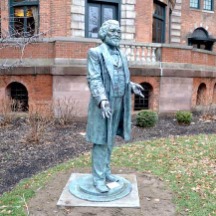Casting his eyes upon the mighty Nile, the world's longest river, Douglass was particularly impressed by its "fertilizing power." He remarked that: "wherever the land is overflowed by it, is very marked, especially in contrast with the sandy desert. It is seen in the deep black and glossy soil, and in the thick and full growth and deep green color of its vegetation. No fences divide field from field and define the possession of different proprietors. To all appearance the land might belong to one man alone. The overflow of the Nile explains this feature of the country, as its mighty floods would sweep away such barriers. The mode of grazing cattle is to us peculiar. The donkeys, horses, cows, and camels are not allowed to roam over the field as with us, but are tethered to stakes driven down in the ground. They eat all before them, leaving the land behind them as though it had been mowed with a scythe or a sickle. They present a pleasant picture, standing in rows like soldiers, with their heads towards the tall vegetation and seemingly as orderly as civilized people at their dining tables."
Looking deeper into other Egyptian agricultural techniques, Douglass observed that: "Egypt may have invented the plow, but it has not improved upon the invention. The kind used there is perhaps as old as the time of Moses, and consists of two or three pieces of wood so arranged that the end of one piece turns no furrow, but simply scratches the soil. Still in the distance, the man who holds this contrivance and the beast that draws it look very much as if they were plowing. I am told, however, that this kind of plow does better service for the peculiar soil of Egypt than ours would do; that the experiment of tilling the ground with our plow has been tried in Egypt and has failed; so that the cultivation of the soil, like many things, is best where it answers its purposes best and produces the best results."
While passing through "Cairo, with its towers, minuets, and mosques," Douglass caught sight of the Pyramids, labelling them at first, "mysterious piles of masonry." He later wrote " ... they stand grandly, in sight of Cairo, just in the edge of the Libyan desert and overlooking the valley of the Nile, as they have stood during more than three thousand years and are likely to stand as many thousand years longer, for nothing grows old here but time, and that lives on forever." He was, however, not fully prepared for what came next; his encounter with the Great Pyramid.
"One of the first exploits a tourist is tempted to perform here," Douglass recounted, "is to ascend to the top of the highest Pyramid. The task is by no means an easy one nor is it entirely free from danger. It is clearly dangerous if undertaken without the assistance of two or more guides. You need them not only to show you where to put your feet, but to lift you over the huge blocks of stone of which the Pyramids are built, for some of these stones are from three to four feet in thickness and height. Neither in ascending nor descending is it safe to look down. One misstep and all is over. I went with seventy years own my head, to the top of the highest Pyramid, but nothing in the world would tempt me to try the experiment again. I had two Arabs before me pulling, and two at my back pushing, but the main work I had to do myself.
I did not recover from the terrible strain in less than two weeks. I paid dearly for the venture.
Still, it was worth something to stand for once on such a height and above the work and the world below. Taking the view altogether--the character of the surroundings, the great unexplained and inexplicable Sphinx, the Pyramids and other wonders of Sakkara, the winding river of the valley of the Nile, the silent, solemn and measureless desert, the seats of ancient Memphis and Heliopolis, the distant mosques, minarets, and stately palaces, the ages and events that have swept over the scene and the millions on millions that lived, wrought and died there--there are stirred in the one who beholds it for the first time thoughts and feelings never thought and felt before. While nothing could tempt me to climb the rugged, steep and perilous sides of the Great Pyramid again, yet I am very glad to have had the experience once, and once is enough for a lifetime."
Douglass and his wife, Helen, had landed in Egypt in February, 1887 and stayed for several weeks. The prow of their ship now turned toward Greece but Egypt never left his thoughts and dreams. Even before the Civil War, he had eloquently defended Africa, her people, and her history from vicious attacks by "thin-souled" minions of the slave power. He wished again "... to look upon Egypt; to stand on the summit of its highest Pyramid; to walk among the ruins of old Memphis; to gaze into the dead eyes of Pharaoh; to feel the smoothness of granite tombs polished by Egyptian workmen three thousand years ago; to see the last remaining obelisk of Heliopolis; to view the land of Goshen; to sail on the bosom of the Nile..."
Read Frederick Douglass in Africa, Part 1 






